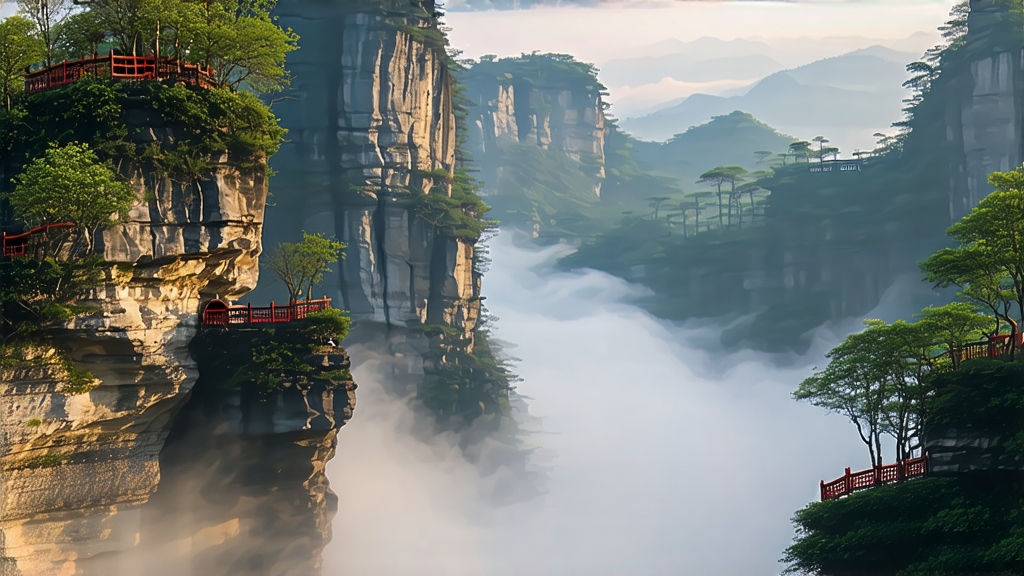
If any single tea can embody the romance, danger, and poetry of Chinese oolong, it is Da Hong Pao—literally “Big Red Robe”—grown on the almost vertical cliffs of northern Fujian’s Wuyi Mountains. To the Chinese palate it is more than a beverage; it is a sip of mineral-rich air, a whisper of dynastic memory, and a master-class in the alchemy of fire, leaf, and stone. International drinkers who meet it for the first time often describe the experience as “drinking a liquid canyon,” an apt metaphor for a tea whose flavor is carved from igneous rock and seasoned by pine-smoke centuries in the making.
Historical myth and archival fact intertwine as tightly as the twisted strips of Da Hong Pao itself. The most repeated legend dates to the Ming dynasty (1368-1644), when a passing scholar, en route to the imperial civil-service examinations, fell ill on the Wuyi trail. Monks from the Tianxin Temple brewed leaves picked from four stunted bushes clinging to a cleft in Jiulongke (“Nine-Dragon Gorge”). The scholar revived, passed the exams with top honors, and returned in triumph, draping his own crimson robe over the bushes to honor their life-saving power. Whether or not the tale is embroidery, court records of 1385 do list “Yan Cha from Wuyi” as tribute tea, and Qing (1644-1912) tax registers quantify annual levies of “4.25 dan of Big Red Robe,” proving the name was already in bureaucratic ink. In 1927 a last Qing-era governor even posted stone sentries beside the original mother bushes, an act that inadvertently foreshadowed the modern Protected Geographical Indication status granted in 2002.
Botanically, Da Hong Pao belongs to the Wuyi qi zhong (“strange cultivar”) collective, a local family of Camellia sinensis var. sinensis adapted to thin, mineral soils. Growers group present-day plantings into three hierarchies. “Mother-tree cuttings,” propagated asexually from the four 350-year-old bushes, are now illegal to harvest; the last authorized picking took place in 2006, and the 20 g of leaf produced was auctioned for RMB 208,000—roughly USD 28,000 per gram. “Pure pedigree” (chun zhong) gardens use first-generation cuttings from those clones, while the vast majority of commercial Da Hong Pao is a skillfully balanced “pin-pegged” blend of three to five Wuyi cultivars—most commonly Qi Dan, Bei Dou, and Rou Gui—designed to mimic the mother tree’s signature “rock rhyme” (yan yun), a lingering mineral sweetness that arrives minutes after swallowing.
The craft sequence is a six-act drama spread across half the calendar year. Plucking occurs from late April to early May, when three half-open leaves are snapped just above the fifth node; the cool gorge mist keeps cell walls tight, locking in aromatic precursors. Withering is done twice—first outdoors on bamboo racks called shai qing, where leaf loses 15 % moisture under the mountain sun, then indoors on water-heated troughs where enzymatic oxidation is coaxed to 30–40 %. The turning point is yao qing, “rocking the green,” a 20-minute rhythmic tossing in rattan drums that bruises leaf edges against veins, jump-starting uneven oxidation and releasing a heady perfume of orchid and ripe apricot. Fixation follows at 220 °C in 60 cm diameter iron woks; the tea master’s bare hand is his thermometer, withdrawing the moment leaf sap sticks to his palm like thin honey. Rolling is still done in cloth bundles twisted foot-by-foot on the floor, a calf-powered motion that breaks cell walls without shredding the leaf. The signature Wuyi charcoal roast distinguishes Da Hong Pao from all other oolongs: strips of leaf are loaded into 8 cm-thick bamboo sieves, stacked inside charcoal-fired ovens constructed from local tuff stone. Over 6–10 hours the leaf is baked at 80–120 °C, rested for a week, then re-baked up to three times, each cycle lowering temperature by 10 °C. The result is a glossy, dark chocolate-colored leaf whose aroma toggles between burnt cream and warm granite.
To brew Da Hong Pao well is to negotiate between its fire and its